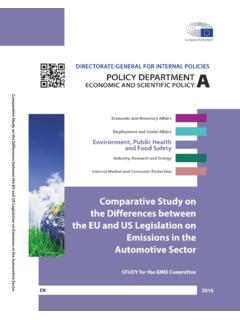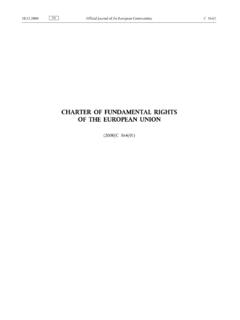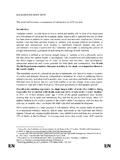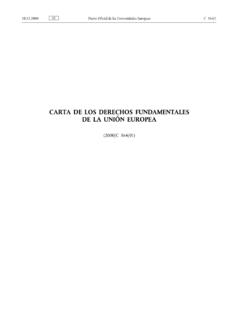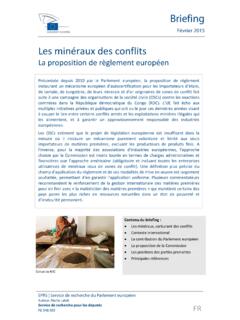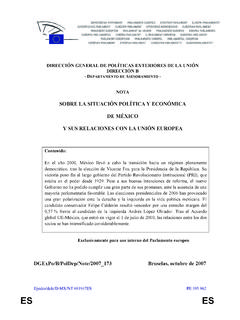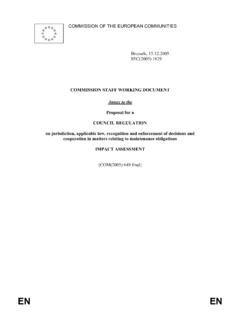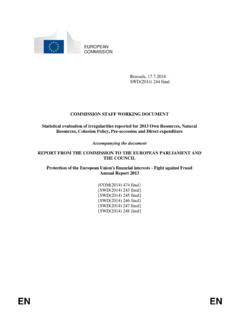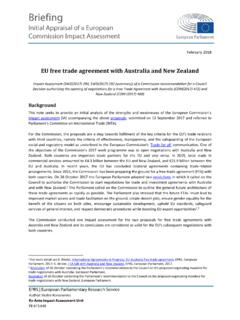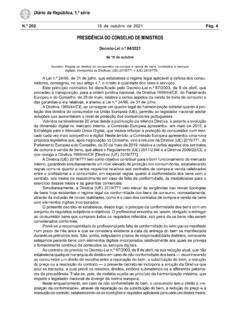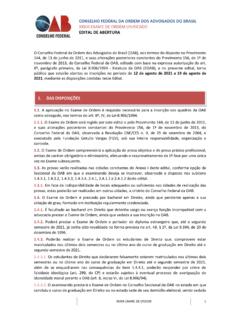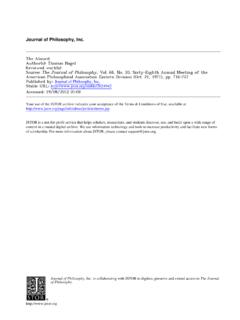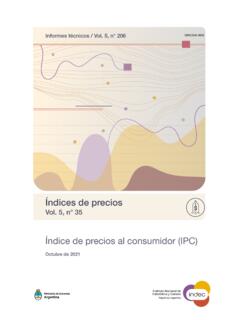Transcription of Understanding energy efficiency - European Parliament
1 Briefing October 2015. Understanding energy efficiency SUMMARY. The European Commission considers energy efficiency as a strategic priority for the energy Union, and promotes ' energy efficiency first' as a principle. It proposes to rethink energy efficiency fundamentally, and treat it as an energy source in its own right. By using energy more efficiently, energy demand can be reduced, leading to lower energy bills for consumers, lower emissions of greenhouse gases and other pollutants, reduced need for energy infrastructure, and increased energy security through a reduction of imports. Worldwide, energy efficiency has contributed to substantial savings in energy consumption. The implementation of energy efficiency policies is challenging, and the full potential of energy efficiency is far from realised, for financial, behavioural and regulatory reasons.
2 Obstacles include high upfront investment costs, access to finance, lack of information, split incentives and rebound effects. The EU has set energy efficiency targets and a set of regulations to promote energy efficiency across the economy. As part of the energy Union strategy, the European Commission plans to propose specific strategies for heating and cooling, and for the transport sector. Key pieces of energy efficiency legislation are to be reviewed in the coming two years, and implementation of the existing framework enforced. Finance for energy efficiency will be given special attention. The European Parliament has repeatedly called for stronger EU energy efficiency targets and policies, and is current preparing own-initiative reports on the energy efficiency Directive and the energy Union strategy.
3 In this briefing: Issue definition EU policy and legislation Implementation and challenges European Parliament Outlook Main references EPRS | European Parliamentary Research Service Author: Gregor Erbach Members' Research Service PE EN. EPRS Understanding energy efficiency Issue definition Fundamental concepts In general terms, energy efficiency refers to the amount of output that can be produced with a given input of energy . Most commonly, energy efficiency is measured as the amount of energy output for a given energy input and listed as a percentage between 0% and 100%, for example the amount of mechanical energy that an electric motor produces for a given input of electrical Assessing energy efficiency However, other kinds of output can also be used.
4 energy efficiency can be assessed at The EU energy efficiency Directive uses a very broad different levels, from economy-wide and definition: sectoral energy intensity to individual units of activity, such as cooking. The energy efficiency ' means the ratio of output of International energy Agency has performance, service, goods or energy , to input produced guidelines for developing and of energy . using energy efficiency indicators for To illustrate these kinds of output, thermal comfort policy-making. in a building is an example of performance; transport At European level, the ODYSSEE-MURE. of persons or of information is a service; a project performs comprehensive smartphone is a good, the production of which monitoring of energy consumption and efficiency trends, as well as an requires energy .
5 Evaluation of energy efficiency policy For an economy-wide measure, GDP is often measures by sector. The ODEX. compared to energy use, to give the energy intensity composite indicator is calculated as a (measured for example in kilowatt-hours per euro).2 weighted average of sectoral indices. It is used by the European Environment energy savings are the reduction of energy use, Agency to assess progress on energy without reference to output produced. efficiency in Europe. The efficiency of the overall energy system is another issue. For example, peaks in electricity demand require spare power plants and extra transmission capacity that make the energy system less Efficient use of energy can be understood in terms of using energy in such a way as to obtain the maximum benefit, but can also imply shifting energy consumption to times when energy is abundant and cheap (for example at night, or during sunny and windy periods when renewable energy sources produce more energy ).
6 Finally, energy is required for the production of energy , for example the drilling of oil wells or the construction of wind turbines. Net energy is the energy produced after deducting the energy used in the Net energy analysis is also applied to measures intended to save energy . Housing insulation, for example, can save 120 times more energy than is used for the production of the insulating materials. energy efficiency can be improved at all points in the chain from energy production to energy consumption. Combined-cycle gas turbines can convert gas to electricity with efficiencies of up to 60%. Waste heat from power generation can be supplied to households and industry (combined heat and power). High-voltage direct current (HVDC) transmission lines can reduce energy losses in the grid.
7 Smart grids and enhanced grid interconnections improve system-wide efficiency by making best use of the grid to connect electricity producers and consumers. Smart meters can promote more efficient use of energy by encouraging consumers to reduce energy consumption, especially at times of peak demand. In the building sector, insulated walls and windows Members' Research Service Page 2 of 10. EPRS Understanding energy efficiency can help reduce energy use without compromising thermal comfort. Condensing furnaces or heat pumps can reduce energy consumption in the heating sector. LED. technology has dramatically improved the efficiency of lighting. In the transport sector, lightweight materials, aerodynamic design and efficient engines can improve the fuel efficiency of vehicles.
8 Costs and benefits of energy efficiency Improved energy efficiency is expected to bring a number of benefits. First of all, by reducing energy usage, energy bills should be reduced for industrial consumers, thereby improving their competiveness. For households, lower energy bills reduce the risk of energy poverty5 and increase spending power. Reduced energy demand also means that energy imports can be decreased6 (contributing to energy security), and energy infrastructure (such as power plants or transmission lines) requirements reduced. Lower energy demand should also lead to a reduction in greenhouse gas emissions, making an essential contribution to climate protection and decarbonisation of the economy. Reduced energy use can contribute to improved air quality and reduced health impacts, as well as lower environmental impacts from energy extraction and use.
9 Finally, the implementation of energy efficiency measures can create new jobs in industry and energy services. Improvements in energy efficiency require an initial investment (and possibly recurrent costs), and generate a return over the lifetime of the investment in the form of energy An energy efficiency measure is said to be cost-effective when the return achieved exceeds the costs. The International energy Agency (IEA) advocates an approach that takes multiple benefits into account when evaluating the cost-effectiveness of energy efficiency projects and policies. The Institute for European Environmental Policy has reviewed the performance of various energy efficiency programmes in Germany, Ireland and Sweden and found that the benefits consistently exceed the costs.
10 In addition to financial costs, there are 'hidden costs' arising from the effort of identifying, evaluating and implementing energy efficiency measures. 8. Rebound effects In many cases, improvements in energy efficiency result in lower energy savings than expected, and can even lead to an increase in energy The reason may be that consumers do not simply replace an old product with a more efficient one with the same specifications, but upgrade to a larger product. For example, they may replace a small but inefficient fridge with a larger, more efficient one, that offers more space, but has similar or even higher energy consumption. Even if a product is replaced with a more efficient one, lower energy bills mean that consumers have more money to spend on goods and services.
